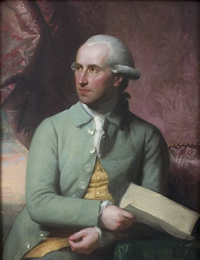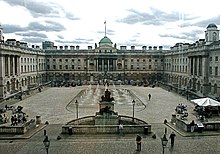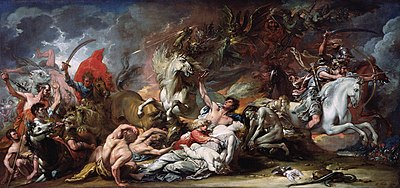
Benjamin West, was a British-American artist who painted famous historical scenes such as The Death of Nelson, The Death of General Wolfe, the Treaty of Paris, and Benjamin Franklin Drawing Electricity from the Sky.

Raphaelle Peale is considered the first professional American painter of still-life.
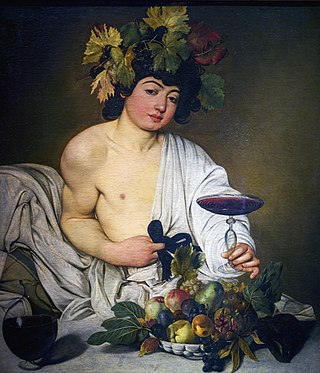
Bacchus is an oil painting by Italian Baroque master Michelangelo Merisi da Caravaggio (1571–1610) commissioned by Cardinal Del Monte. The painting shows a youthful Bacchus reclining in classical fashion with grapes and vine leaves in his hair, fingering the drawstring of his loosely draped robe. On a stone table in front of him is a bowl of fruit and a large carafe of red wine. He holds out a shallow goblet of the same wine, inviting the viewer to join him. The painting is currently held in the Uffizi Gallery in Florence.

James Earl was an American painter and younger brother of fellow portrait painter Ralph Earl. He was born in Leicester, Massachusetts, and died of yellow fever in Charleston, South Carolina. He lived and worked in London for ten years, where he married and had three children and enrolled in the Royal Academy in 1789. His British clientele were mostly Loyalists living in exile, though there is no evidence that he was a committed Loyalist himself. Among his best known works are Rebecca Pritchard Mills and Her Daughter Eliza Shrewsbury and a portrait of Charles Cotesworth Pinckney.
Boscotrecase is a comune (municipality) in the Metropolitan City of Naples in the Italian region Campania, located about 20 km southeast of Naples.

Edmund Clark Sanford (1859–1924) was an early American psychologist. He earned his PhD under the supervision of Granville Stanley Hall at Johns Hopkins University, and then moved with Hall to Clark University in 1888, where he became the professor of psychology and the founding director of the psychology laboratory. He is best known for his 1887 Writings of Laura Bridgman and for his 1897 textbook, A Course in Experimental Psychology. This textbook was a manual on how to conduct experiential psychology. He was present at the creation of the American Psychological Association in 1892 and the creation of the Association of American Universities in 1900. He was the cousin of another early psychologist, Milicent Shinn.

The Apocalypse, properly Apocalypse with Pictures, is a series of fifteen woodcuts by Albrecht Dürer published in 1498 depicting various scenes from the Book of Revelation, which rapidly brought him fame across Europe. These woodcuts likely drew on theological advice, particularly from Johannes Pirckheimer, the father of Dürer's friend Willibald Pirckheimer.

The Rocky Mountains, Lander's Peak is an 1863 landscape oil painting by the German-American painter Albert Bierstadt. It is based on sketches made during Bierstadt's travels with Frederick W. Lander's Honey Road Survey Party in 1859. The painting shows Lander's Peak in the Wind River Range of the Rocky Mountains, with an encampment of Native Americans in the foreground. It has been compared to, and exhibited with, The Heart of the Andes by Frederic Edwin Church. Lander's Peak immediately became a critical and popular success and sold in 1865 for $25,000.
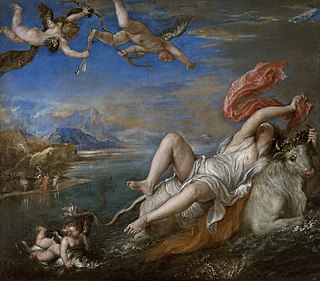
The Rape of Europa is a painting by the Venetian artist Titian, painted ca. 1560–1562. It is in the permanent collection of the Isabella Stewart Gardner Museum of Boston, Massachusetts. The oil-on-canvas painting measures 178 by 205 centimetres.

The Fog Warning is one of several paintings on marine subjects by the late-19th-century American painter Winslow Homer (1836–1910). Together with The Herring Net and Breezing Up, painted the same year and also depicting the hard lives of fishermen in Maine, it is considered among his best works on such topics.

The Death of General Mercer at the Battle of Princeton, January 3, 1777 is the title of an oil painting by the American artist John Trumbull depicting the death of the American General Hugh Mercer at the Battle of Princeton on Friday, January 3, 1777, during the American Revolutionary War. The painting was Trumbull’s first depiction of an American victory. It is one of a series of historical paintings on the war, which also includes the Declaration of Independence and The Capture of the Hessians at Trenton, December 26, 1776.
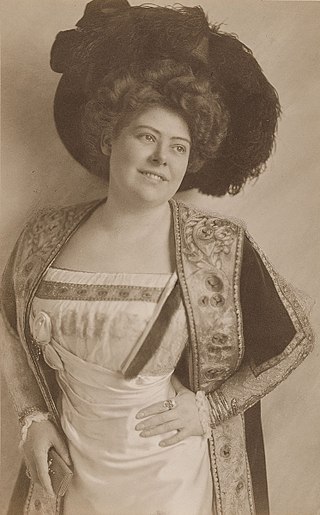
Minya Diez-Dührkoop or Dièz-Dührkoop was a German photographer.
The Bahi Rock-Art Sites or Bahi rock paintings are rock art located at three sites in the Dodoma region of Tanzania. These white paintings are believed to be products of the Wamia people, who occupied the region before the Wagogo people. The paintings, which depict cattle, human figures, stools, gourds, a bird, and an arrow, among other symbols, were supposedly executed during important occasions such as funerals. The Wagogo people, though not fully aware of the original significance of the paintings to the Wamia, have continued to use the sites as sacred locations for rain-making ceremonies. The Bahi paintings are estimated to be at least 340 years old based on the genealogy of the Bahi chief in 1929, which revealed the estimated time of his ancestor Kimanchambogo's arrival in the area. The white painting method is generally associated with Bantu-speaking farming populations.

Benjamin Franklin Drawing Electricity from the Sky is a c. 1805 painting by Benjamin West in the Philadelphia Museum of Art. It depicts American Founding Father Benjamin Franklin conducting his kite experiment in 1752 to ascertain the electrical nature of lighting. West composed his 13.25 in × 10 in work using oil on a slate. The painting blends elements of both Neoclassicism and Romanticism. Franklin knew West, which influenced the creation of this painting.

Daniel Chester French (1850–1931) was an American sculptor who was active in the nineteenth and twentieth centuries. He was born in Exeter, New Hampshire, to Anne Richardson French and Henry Flagg French on April 20, 1850. His father, a polymath, was a judge and college president who popularized the French drain. In 1867, the family moved to Concord, Massachusetts, and French enrolled at the Massachusetts Institute of Technology. French did not perform well academically and, after a year, he left the college and returned to Concord where he first learned sculpture while attending art classes with Louisa May Alcott. Between 1869 and 1872, French studied anatomy with William Rimmer, and in 1870 he undertook a one-month apprenticeship with the sculptor John Quincy Adams Ward. After completing The Minute Man in 1875, French studied sculpture in Florence, Italy, for a year, during part of which he worked out of Thomas Ball's studio.

The Veteran in a New Field is an oil-on-canvas painting by the 19th-century American artist Winslow Homer. It is set in the aftermath of the American Civil War and is often interpreted as an emblem of postbellum American society. The painting depicts a farmer harvesting wheat in a field with a scythe. The farmer in the painting is identified as a former Union Soldier from his discarded jacket and canteen in the right foreground of the painting. This painting was one of several that Homer did on the American Civil War, including his previous works Home, Sweet Home and Prisoners from the Front. The Veteran in a New Field is a transitional painting in Homer's body of work. It comments on the postbellum return of soldiers to daily life and the history of death that they bring along with them. It uses biblical themes to comment on war and nature, while also alluding to stories from classical history.

The Thomas Gallaudet Memorial is a sculpture by Daniel Chester French located on the campus of Gallaudet University in Washington, D.C., United States. The 1889 statue depicts Thomas Hopkins Gallaudet sitting in a chair and Alice Cogswell standing at his side.
Hermann Traugott Louis Fuechsel, also known as Füchsel or Fuchsel, was a German-American landscape painter, and member of the Düsseldorf school and Hudson River School.
Milo Merle Naeve was an American art historian, curator, and museum administrator who worked at the Winterthur Museum, Garden and Library, Colonial Williamsburg, the Colorado Springs Fine Arts Center, and the Art Institute of Chicago, where he held the first curatorship in American arts and the first endowed curatorship at the Institute.

Quilting Frolic is an oil-on-canvas genre painting by American artist John Lewis Krimmel (1786–1821). It was painted in Philadelphia in 1813. Purchased in 1953, the work is held in the permanent collection of the Winterthur Museum, Garden and Library. The painting depicts an interior domestic scene of merrymaking with a Black child serving and a Black fiddler entertaining partygoers celebrating the completion of a quilt.

